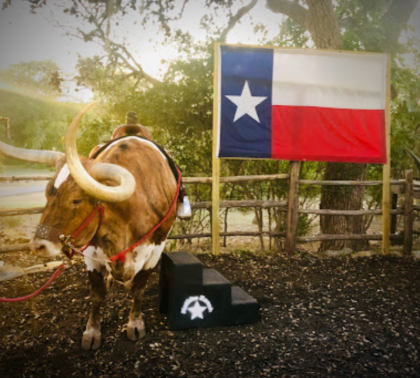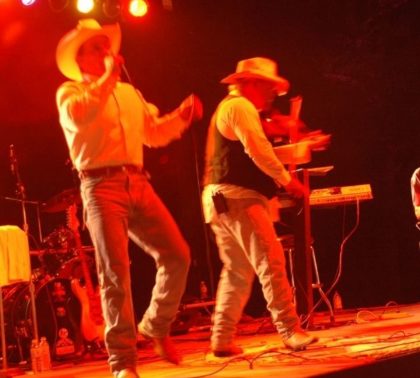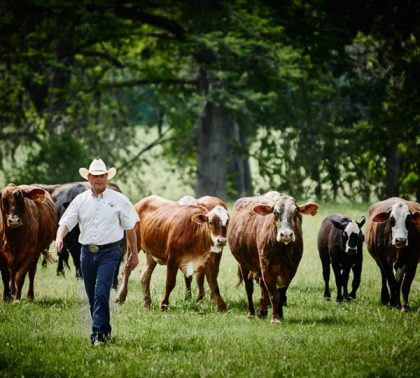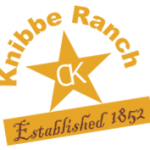About
The Knibbe Ranch was founded back in 1852, more than 150 years ago. The Knibbe Ranch (we pronounce it ka-NIB-bee) is one of the few remaining Century Heritage Ranches in the State of Texas, which means the Knibbe Family has been in a continuous agricultural endeavor (cattle) for over a century.
Located only 28 miles north of downtown San Antonio in the beautiful Texas Hill Country, the historic Knibbe Ranch is rich in German heritage and culture reminiscent of the early European immigrants.
We are a working beef cattle ranch, with a thriving cow-calf operation. Our breeding program involves F-1 Tiger Stripe cattle.
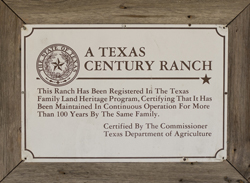 Knibbe Ranch History
Knibbe Ranch History
Founded over 150 years ago in 1852, the Knibbe Ranch is one of the few remaining Century Heritage Ranches in the State of Texas. Century Heritage Ranches must be owned and operated by the same family in a direct line of descent.
Located only 28 miles north of downtown San Antonio in the beautiful Texas Hill Country, the historic ranch is rich in German heritage and culture reminiscent of the early European immigrants.
From Germany to Spring Branch, Texas
In 1848, Hans Heinrich Dietrich Knibbe, of Bissendorf, Germany immigrated to Texas on the sailing vessel George Dillus. Before arriving at Indianola, Texas, the George Dillus ran onto a reef. Passengers had to throw all their farming equipment overboard to get the ship afloat. Dietrich started his new life in Texas with no farming equipment and very few personal belongings.
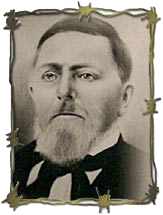 He had on account with the German Emigration Society, funds to buy land. He had a choice between good farmland in the New Braunfels-Seguin area for 50 cents an acre, or the area around Spring Branch along the Guadalupe River for a dollar an acre. The higher-priced Spring Branch area reminded Dietrich of Germany, so he became the first settler in Spring Branch.
He had on account with the German Emigration Society, funds to buy land. He had a choice between good farmland in the New Braunfels-Seguin area for 50 cents an acre, or the area around Spring Branch along the Guadalupe River for a dollar an acre. The higher-priced Spring Branch area reminded Dietrich of Germany, so he became the first settler in Spring Branch.
Eventually Dietrich Knibbe acquired almost 22,000 acres of land. He raised oxen for farming and transportation. He built a sawmill, flourmill, and shingle mill on 20,000 acres skirted by the Guadalupe River.
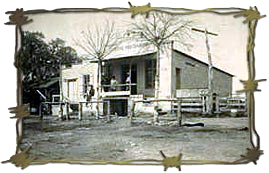 In the late 19th century, Spring Branch became quite a thriving community with
In the late 19th century, Spring Branch became quite a thriving community with
• The Spring Branch post office
• The Knibbe General Store
• The Knibbe Brothers cotton gin
• A blacksmith shop
• The Spring Branch dance hall, and Saloon
• The Spring Branch one-room school.
All these sites are still on or near the present ranch. Up until the early 1900s, the main route from San Antonio to Blanco and places north was through Spring Branch.
The Knibbe Ranch Today
Dietrich Knibbe’s great-great grandson, fifth-generation descendant Charles J. “Chuck” Knibbe, and his wife Sharon operate and manage the Knibbe Ranch today. Their daughter, Shannon and their son Chad with his wife Callie, and their 4 children live on the ranch. These grandchildren represent the 7th generation of Knibbes to live on the ranch The land has been in continuous agricultural operation by the same family since 1852 and is therefore recognized as a Century Heritage ranch by the State of Texas.
The ranch is representative of the Texas Hill Country with rolling hills, beautiful meadows, the Guadalupe River as its southern boundary, and the Spring Branch Creek with its many springs flowing through the middle. Hundreds of beautiful, sprawling live oak trees cover the hills, and cypress, sycamore, and pecan trees line the creek and river bottoms.
Cattle
 For more than 150 years, cattle have been the mainstay of the Knibbe Ranch. The breed of choice for most of that time was the familiar red, white-faced Hereford, known for its hardiness and size and prized for beef production.
For more than 150 years, cattle have been the mainstay of the Knibbe Ranch. The breed of choice for most of that time was the familiar red, white-faced Hereford, known for its hardiness and size and prized for beef production.
Since 1996, the Knibbes have focused on producing a specialty hybrid nicknamed F-1 Tiger Stripes. These cattle are the first cross between purebred Hereford cattle and purebred Brahman cattle.
The Knibbes believe that crossing these two extreme species, Bos taurus and Bos indecos, achieves the highest degree of heterosis — or hybrid vigor. The F-1 female has bred-in environmental adaptivity, increased milk production, higher fertility and the heat and disease resistance of her Brahman parent. The Knibbes feel these cattle adapt best to the Texas Hill Country and bring an optimum price at market.
Wildlife
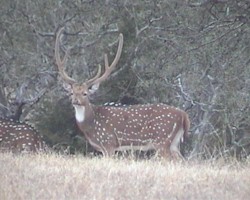
The Knibbe Ranch is a typical Hill Country ranch in Texas: wildlife is abundant. The herds of white tail deer increase each year as surrounding ranches are sold and more deer are pressed onto the ranch.
Axis deer are also becoming quite numerous, along with feral hogs, jack rabbits and cottontail rabbits.
Wild Rio Grande turkeys abound. Red fox, gray fox, raccoons, ringtails and opossums abound. The state animal of Texas, the armadillo, can be seen frequently rooting around the woods.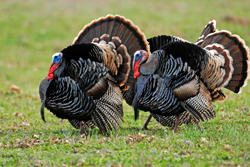
The variety of trees and the abundant waters of the Guadalupe River and the Spring Branch creek create a tremendous habitat for a variety of birds. Bird watchers can see hawks, blue herons, kingfishers, wood ducks, doves, cardinals, meadowlarks, horned owls, barn swallows, blue birds, and more.
Prehistoric Finds
As far back as 8,000 years ago, hunter-gatherers used the Knibbe Ranch as a base to hunt buffalo. How do we know?
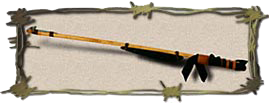 Several sites of prehistoric nomadic Indian campgrounds from the Paleolithic to Late Archaic periods have been found on the ranch.
Several sites of prehistoric nomadic Indian campgrounds from the Paleolithic to Late Archaic periods have been found on the ranch.
The age of Knibbe site #1 is estimated to range from approximately 8,000 years before the present to 500 years before the present.
This estimated range is derived from the presence of one basal fragment of an Andice point found in the lower part of the site and the presence of a Perdiz point found in the upper part of the site.
There are at least 5 other sites on the ranch with an ongoing dig at Site #3.
Buffalo Jump
A large number of bison bones have been found at the base of the cliff overlooking this site, which indicates that Site #2 is an authentic bison kill site.
Atlatl Demonstrations
 Guests to the ranch are introduced to and can experiment with the “atlatl,” the spear-throwing weapon of the period. This weapon creates the thrust needed to kill smaller animals like deer or antelope.
Guests to the ranch are introduced to and can experiment with the “atlatl,” the spear-throwing weapon of the period. This weapon creates the thrust needed to kill smaller animals like deer or antelope.

